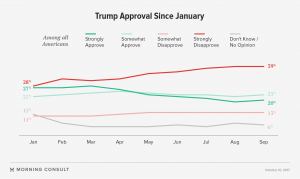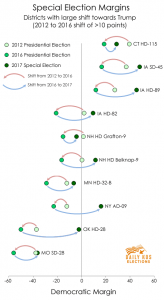The following article by Democratic strategist Robert Creamer, author of Stand Up Straight: How Progressives Can Win, is cross-posted from HuffPo:
No one really believes that an even moderately rational leader of North Korea would use nuclear weapons to launch a first strike against the United States. Such a move would almost certainly lead to the annihilation of North Korea itself – and its leadership. It would be suicidal.
But history shows that the confrontation between the United States and North Korea still carries with it enormous danger: the danger that a horrific conventional or nuclear war could occur as a result of miscalculation or mistake. And the likelihood of such a catastrophe increases exponentially when the leaders who could launch a war are impulsive, erratic megalomaniacs like Kim Jong Un and Donald Trump.
During the Cuban Missile Crisis in 1962, historians have identified dozens of close calls – miscalculations or mistakes – that could have led to a nuclear war.
On October 27, 1962, the Soviet Fox-Trot class diesel submarine B-59 was cruising in waters off Cuba near the U.S. Aircraft Carrier USS Randolph and nine destroyers. The submarine B-59 was in international waters, but as part of the U.S. naval blockage of Cuba, the destroyers began dropping depth charges around the B-59 signaling it to surface to be identified.
The B-59 had been cruising too deep to monitor U.S. broadcasts and had not been in touch with Moscow for three days. Fearing that the depth charging meant that a war had already broken out, the Captain of the B-59, Valentin Grigorievitch Savitsky decided to launch the ship’s nuclear-tipped torpedoes at the attacking U.S. ships.
Normally, the Captain only had to get agreement from his political officer to launch nuclear-tipped torpedoes or missiles. Luckily, on the B-59 the Captain, his political officer Ivan Maslennikow, and the second-in-command Vasili Arkhipov had agreed that all three must unanimously agree before the B-59’s nuclear armaments were used. This stemmed partially from the lucky coincidence that Ankhipov, though he was only second-in-command on the B-59, was commander of the entire flotilla of submarines and of equal rank with the Captain.
The Political Officer agreed with the Captain to use the nuclear-tipped torpedoes. Only Ankhipov refused to agree and ultimately convinced the Captain to surface and contact Moscow. Ankhipov’s case was bolstered by the lucky fact that the sub’s batteries were low, the air conditioning had failed, and heat and carbon dioxide levels onboard had risen.
He might not have realized it at the time, but Ankhipov’s good judgment and resolve probably prevented a nuclear war. But what if it had been a different sub?
Historian Graham Allison begins his new book Destined for War, by quoting German chancellor Theobald von Bethman Hollweg. “Ah, if we only knew,” he said when pressed by a colleague to explain how his choices, and those of other European statesmen, had led to the most devastating war the world had seen to that point – World War I.
Allison goes on to note that none of the major actors in Europe wanted a war. And by the time it was over in 1918 the key players had all lost what they fought for: “the Austro-Hungarian Empire dissolved, the German Kaiser ousted, the Russian tsar overthrown, France bled for a generation, and England shorn of it treasure and youth. And for what. If we only knew.”
The major actors unthinkingly made mistake after mistake and “blundered into the abyss.”
In his December, 2016 article in the New Yorker entitled, World War Three, by Mistake, Eric Schlosser says: “Harsh political rhetoric, combined with the vulnerability of the nuclear command-and-control system, has made the risk of global catastrophe greater than ever.”
He goes on to describe a terrifying episode:
On June 3, 1980, at about two-thirty in the morning, computers at the National Military Command Center, beneath the Pentagon, at the headquarters of the North American Air Defense Command (norad), deep within Cheyenne Mountain, Colorado, and at Site R, the Pentagon’s alternate command post center hidden inside Raven Rock Mountain, Pennsylvania, issued an urgent warning: the Soviet Union had just launched a nuclear attack on the United States. The Soviets had recently invaded Afghanistan, and the animosity between the two superpowers was greater than at any other time since the Cuban Missile Crisis.
U.S. Air Force ballistic-missile crews removed their launch keys from the safes, bomber crews ran to their planes, fighter planes took off to search the skies, and the Federal Aviation Administration prepared to order every airborne commercial airliner to land.
President Jimmy Carter’s national-security adviser, Zbigniew Brzezinski, was asleep in Washington, D.C., when the phone rang. His military aide, General William Odom, was calling to inform him that two hundred and twenty missiles launched from Soviet submarines were heading toward the United States. Brzezinski told Odom to get confirmation of the attack. A retaliatory strike would have to be ordered quickly; Washington might be destroyed within minutes. Odom called back and offered a correction: twenty-two hundred Soviet missiles had been launched.
Brzezinski decided not to wake up his wife, preferring that she die in her sleep. As he prepared to call Carter and recommend an American counterattack, the phone rang for a third time. Odom apologized—it was a false alarm. An investigation later found that a defective computer chip in a communications device at norad headquarters had generated the erroneous warning. The chip cost forty-six cents.
Let’s remember what a nuclear war is all about. One study showed that a single 1-megaton bomb exploded above the city of Detroit would cause up to 630,000 deaths and injuries from blast alone. And many of those who escaped death initially would ultimately suffer horrific deaths from the effects of nuclear fallout or burns.
In all three of these instances, the decisions leading to a war – or almost leading to a war – did not involve a grand design or conscious action. They involved mistakes or near mistakes that were, or could have been catastrophic. And their likelihood of doing so vastly increases if they are made by erratic, impulsive people who lack self-confidence and a sense of history – people like Donald Trump or Kim Jong Un.
Every day, there are reports of a lover or spouse who kills his or her significant-other in a fit of uncontrolled anger or rage. These are not cases where one spouse wakes up one day and coolly decides to kill the other. The man murders his wife in a fit of uncontrolled passion.
Everyday you hear of teenagers who get into a fight over a girlfriend, pull guns and ruin each other’s lives because somebody insulted somebody else. Neither rationally planned the attack; the names start flying, the hormones start flowing, and pretty soon one or more kids lies dead on a sidewalk or a barroom floor.
Donald Trump seems to have the emotional maturity of one of those teenagers. And remember that the kids who shoot at each other in a dispute over a girlfriend would be throwing punches rather that shooting bullets if they did not have access to guns.
Donald Trump has control of the nuclear launch codes to thousands of nuclear weapons.
And the likelihood of a mistake or miscalculation is not simply limited to national leaders. Once the stakes go up and forces are entangled, the mistakes or miscalculations of scores – or even hundreds – of people who are outside of the span of control of national leaders can snowball into international calamity.
At one point in the Cuban Missile, Kennedy elevated the alert level to Defcon II. With that order German and Turkish pilots took their seats in the cockpits of NATO fighter-bombers, armed with nuclear weapons, ready to attack. If one of those Turkish or German pilots had gone rogue, that one pilot could have started World War III by flying 2 hours or less and dropping his nuclear payload.
That’s why it is so critical that in the cases of both North Korea and Iran, the leadership of the United States lowers the tension. In reality, of course, Donald Trump has done everything he can to bring tensions to the boiling point.
In a world brimming with nuclear weapons, our true national security has very little to do with whether our president can do a better job slinging insults than the leader of North Korea. It has everything to do with avoiding another horrific war – and in particular a nuclear war.
The willingness of North Korea to limit its nuclear program has everything to do with the willingness of the United States to give North Korea credible assurance that it will not attack them, nor seek to change their regime. Every time Trump escalates military threats he does more to convince them that their only defense is nuclear arms.
The North Koreans saw what happened to Libya’s Muammar Gaddafi when he ended his nuclear weapons program, and they don’t want it to happen to them.
And, of course, if Trump abandons the Iran Nuclear Agreement, then the North Koreans will be completely convinced that they can’t trust any deal to limit their nuclear program that is agreed to by the United States.
Instead, the United States should use strong economic sanctions to pressure North Korea to the bargaining table and provide an off-ramp for them that guarantees their security ― the same way the Obama Administration did so effectively with Iran.
With the advent of nuclear weapons that are capable of destroying our species, human survival depends on our ability to develop non-violent means of conflict resolution that do not involve war.
Like it or not, knowledge and technology will continue to spread. The only long-term solutions to our survival are strong international agreements to limit and then eliminate the use of that technology to produce nuclear arms at all. And to devise political structures that resolve differences fairly and democratically across the face of the planet.
This is not a radical idea. Mainstream leaders like Pope Francis, former Reagan Secretary of State George Shultz, and Clinton Secretary of Defense William Perry have all called for enforceable international agreements to eliminate all nuclear weapons – including those controlled by the United States and Russia.
In the end, any thing short of that leaves our own security at terrible risk. And those who bluster on about making America “Great Again” by wiping other countries off the face of the earth, are jeopardizing that security more than anyone else.






